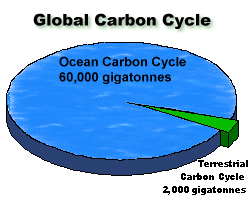Ocean phyto-plankton are the bonsai "trees" in the greatest forests on Earth. In every ocean of the world the bottom of the food chain and foundation for all life are the multitudes of tiny microscopic plants collectively known as phyto-plankton.
Phyto-plankton Productivity Animation

Sea Wifs satellite tracking chlorophyll concentration
Nov 98 - Oct 99
Two thirds of the Earth is covered by oceans and it is within those oceans that the majority of life on this planet resides. Since the oceans are also a deep 3-dimensional growth media and one where habitat extremes are reduced, a much greater productivity is possible. More biomass grows in the world's oceans each year than on all of this planets "earth".
Open ocean regions have long been considered to be the marine deserts because the standing stocks of living organisms and the rates of carbon production in these habitats was thought to be very low. These same open ocean ecosystems were also believed to lack seasonality, perhaps approaching a steady-steady climax community. A new view of the "oligotrophic" ocean is now in hand. However, the latest investigations of the largest of these regions, the North Pacific Subtropical Gyre, have revealed an unexpectedly rich and dynamic system with high rates of gross primary production (1 g C m-2 d-1) and complex, decoupled seasonal patterns of carbon production, consumption and export. In addition to these 'seasonal' variations, there is growing evidence for decade-scale variability as evidenced by changes in plankton community structure. Gross primary production in these open ocean systems is dominated by picoplankton whereas export production and net carbon sequestration are controlled by eukaryotes, particularly diatoms. These complex trophic interactions are probably climate and micro-nutrient sensitive, which may explain the interannual and interdecadal variations that have been observed. In the ocean the 'biological pump' (left) and the 'solubility pump' (right) maintain a concentration gradient of CO2 between the atmosphere and the deep ocean. Keep in mind that what is known as the surface ocean, is the top 100 meters or so, and the deep ocean which is the rest of the ocean on average 3000+meters and in places almost 10,000 meters. The far left column graphic is more representative of the scale of ocean zones. 
Ocean CO2 Cycle The 'biological pump' is driven by phytoplankton-based primary production. Using sunlight for energy and dissolved inorganic nutrients (such as nitrogen, phosphorus, silicon and iron) phytoplankton convert CO2 to organic carbon. As organic carbon passes through the marine food web, much of it is converted back to CO2 in surface waters through respiration and returned to the atmosphere. A fraction of biogenic carbon estimated by various experts to range between 20-50% finds its way into the deep ocean where a portion is remineralized back to CO2. All the biogenic carbon reaching deep waters remains trapped for hundreds to thousands of years. The marine food web's structure and the relative abundance of species influences how much CO2 will be biologically transferred to the deep ocean. The 'solubility pump' is driven by chemical and physical processes. Understanding carbon in the ocean and carbon on land is an important facet of understanding the global carbon cycle. The oceans are by far the greatest repository of carbon on the planet. Does Biomass Carbon Sequestration Produce Environmental Impacts? Carbon sequestration programs on land in forests and agricultural soils are becoming established as useful tools to mitigate climate change. In general most authorities rank the enrichment of plant ecosystems whether this be growth of forests, prairie grasses, or large ocean pastures as a positive environmental action with many associated benefits via the enrichment of associated fish and wildlife resources. However only a few score years ago forests were considered unproductive and a poor use of land and in some parts of the world this attitude perseveres. Whether carbon biomass sequestration will create negative impacts on the earth or in the oceans is largely going to be an issue of how concentrated any such effect might be in a given environmental domain. It is useful to keep in perspective the relative size of the terrestrial vs. oceanic carbon sinks. Carbon in forests and soils worldwide together hold just under 2,000 gigatonnes of carbon. The oceans hold 50 - 60,000 gigatonnes. Since the oceans cover approximately 2/3rds of our planet it's clear this enhanced capacity with regard to carbon is due to the deep three dimensional character and much more moderate environment of the oceans as opposed to terrestrial domains. 
The ocean "carbon sink" is very capable of absorbing an much larger increment of additional carbon than terrestrial systems and hence we can expect any detrimental environmental consequences to be far less dramatic than similar programs imposed on terrestrial systems. Just look at some of the satellite images on these pages showing the green regions of the worlds oceans. Compare this with the very restricted regions of the worlds landscape suited to forestry and soil carbon sequestration programs. It's clear that the ocean environment is the place where we can do the most while interacting and impacting on the environment the least. An advantage of ocean biomass sequestration is that such carbon sequestered in the ocean is quite literally "sunk" within weeks or months of being captured from the air/water. Once in the deep ocean it is in a circulation system commonly measured in a millennial time frame. By the time this carbon reaches the sea bed it has entered the earths geological cycle. Carbon in terrestrial systems remains as organic carbon and is subject to very active biological cycling. For instance a forest planted to sequester carbon might lose that carbon back to the air in a catastrophic forest fire or if the forest suffers disease or infestation. Land based sequestration plantations are slow growing and require active monitoring and management for the lifetime of the plantation usually many decades. The carbon within those systems is never removed permanently from the atmospheric system.
|